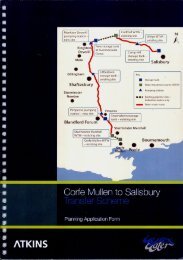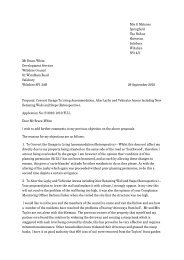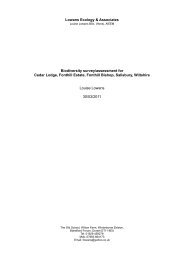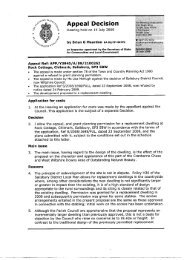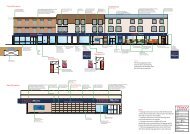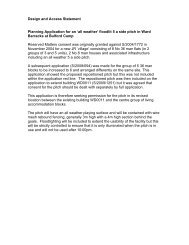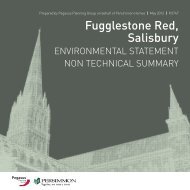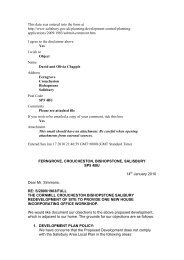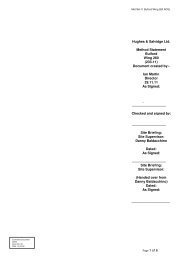English Heritage Stonehenge Environmental Improvements Project ...
English Heritage Stonehenge Environmental Improvements Project ...
English Heritage Stonehenge Environmental Improvements Project ...
Create successful ePaper yourself
Turn your PDF publications into a flip-book with our unique Google optimized e-Paper software.
Table 1 Criteria used in evaluating the relative botanical importance of habitats<br />
Value<br />
Examples of Evaluation Criteria<br />
International Importance • High importance and rarity, international scale and limited potential for<br />
substitution;<br />
• A internationally designated site (Special Area of Conservation SAC, Special<br />
Protection Areas SPA);<br />
• Presence of Internationally rare species;<br />
• Woodland: Semi-Natural Ancient Woodland greater than 20ha including a<br />
combination of type stands;<br />
• Grassland: Unimproved and species-rich grassland greater than 0.5 ha including<br />
internationally rare habitats;<br />
• Arable sites with threshold scores of more than 90 points 11 .<br />
National Importance • High importance and rarity, national scale, or regional scale with limited<br />
potential for substitution;<br />
• A nationally designated site (Sites of Special Scientific Interest (SSSIs), National<br />
Nature Reserves (NNRs) etc.;<br />
• A viable area of a priority habitat identified in the UK BAP, or of smaller areas of<br />
such habitat which are essential to maintain the viability of a larger whole;<br />
• Woodland: Semi-Natural Ancient Woodland greater than 5ha;<br />
• Grassland: Unimproved grassland greater than 10 hectares; over 10 positive or<br />
unimproved grassland indicators;<br />
• Arable sites with threshold scores of 45-89 points.<br />
Regional Importance • High or medium importance and rarity, local or regional scale, and limited<br />
potential for substitution.<br />
• Any regularly occurring, locally significant population of a Nationally Scarce<br />
species (occurs in between 16 to 100 10km squares of the national grid) or in a<br />
Regional BAP or relevant Natural Area on account of its regional rarity or<br />
localisation; or<br />
• Woodland: Semi-Natural Ancient Woodland between 2 and 5ha;<br />
• Grassland: Unimproved grassland greater than 0.5 hectares, over 10 positive or<br />
unimproved grassland indicators.<br />
County Importance • High or medium importance and rarity, local or regional scale, and limited<br />
potential for substitution. A site designated as being of County Importance i.e.<br />
County Wildlife Site (CWS);<br />
• A viable area of Key Habitat identified in the County BAP;<br />
• Any regularly occurring locally significant population of a species which is listed<br />
in a County Red Data Book, BAP or County Rare Plant Register on account of its<br />
regional rarity or localisation;<br />
• A regularly occurring locally significant number of a County important species;<br />
• Woodland: Semi-Natural Ancient Woodland greater than 0.25 ha with 10 or<br />
more AWIS;<br />
• Grassland: Unimproved grassland greater than 0.5 hectare with 6 positive or<br />
unimproved grassland indicators;<br />
• Arable sites with threshold scores of 30-44 points. Vascular ;<br />
• Plants: According to KWT 2005 12 , >150 points (locally scarce or rare in County<br />
= 25 points).<br />
11<br />
Byfield, A. and Wilson, P. (2005). Important Arable Plant Areas: Identifying priority sites for arable plant conservation in the<br />
United Kingdom. Plantlife International, Salisbury, UK.<br />
12<br />
Kent Wildlife Trust, 2005 Local Wildlife Sites in Kent Criteria for Selection and Delineation. Kent Wildlife Trust.<br />
September 2008 3 Phase II Botanical Surveys<br />
11108605R_Botanical_DW_09-08<br />
Chris Blandford Associates



